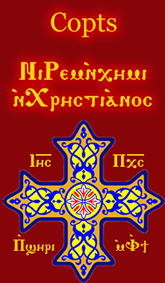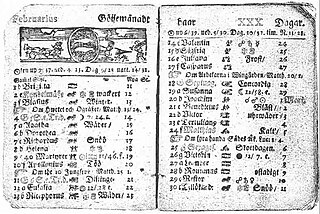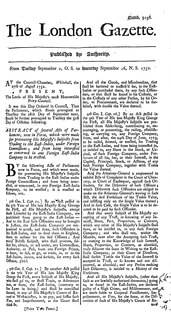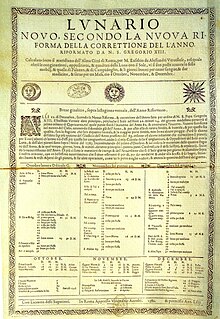Related Research Articles
A calendar is a system of organizing days for social, religious, commercial or administrative purposes. This is done by giving names to periods of time, typically days, weeks, months and years. A date is the designation of a single, specific day within such a system. A calendar is also a physical record of such a system. A calendar can also mean a list of planned events, such as a court calendar or a partly or fully chronological list of documents, such as a calendar of wills.
Intercalation or embolism in timekeeping is the insertion of a leap day, week, or month into some calendar years to make the calendar follow the seasons or moon phases. Lunisolar calendars may require intercalations of both days and months.
The Julian calendar, proposed by Julius Caesar in 46 BC, was a reform of the Roman calendar. It took effect on 1 January 45 BC, by edict. It was the predominant calendar in the Roman world, most of Europe, and in European settlements in the Americas and elsewhere, until it was refined and gradually replaced by the Gregorian calendar, promulgated in 1582 by Pope Gregory XIII.
A leap year is a calendar year containing one additional day added to keep the calendar year synchronized with the astronomical or seasonal year. Because seasons and astronomical events do not repeat in a whole number of days, calendars that have the same number of days in each year drift over time with respect to the event that the year is supposed to track. By inserting an additional day or month into the year, the drift can be corrected. A year that is not a leap year is called a common year.
The Revised Julian calendar, also known as the Milanković calendar, or, less formally, new calendar, is a calendar proposed by the Serbian scientist Milutin Milanković in 1923, which effectively discontinued the 340 years of divergence between the naming of dates sanctioned by those Eastern Orthodox churches adopting it and the Gregorian calendar that has come to predominate worldwide. This calendar was intended to replace the ecclesiastical calendar based on the Julian calendar hitherto in use by all of the Eastern Orthodox Church. The Revised Julian calendar temporarily aligns its dates with the Gregorian calendar proclaimed in 1582 by Pope Gregory XIII for adoption by the Christian world. The calendar has been adopted by the Orthodox churches of Constantinople, Albania, Alexandria, Antioch, Bulgaria, Cyprus, Greece, Poland, and Romania.

The Coptic calendar, also called the Alexandrian calendar, is a liturgical calendar used by the Coptic Orthodox Church and also used by the farming populace in Egypt. This calendar is based on the ancient Egyptian calendar. To avoid the calendar creep of the latter, a reform of the ancient Egyptian calendar was introduced at the time of Ptolemy III which consisted of the intercalation of a sixth epagomenal day every fourth year. However, this reform was opposed by the Egyptian priests, and the reform was not adopted until 25 BC, when the Roman Emperor Augustus imposed the Decree upon Egypt as its official calendar. To distinguish it from the Ancient Egyptian calendar, which remained in use by some astronomers until medieval times, this reformed calendar is known as the Coptic calendar. Its years and months coincide with those of the Ethiopian calendar but have different numbers and names.

New Year's Day, also simply called New Year or New Year's, is observed on January 1, the first day of the year on the modern Gregorian calendar as well as the Julian calendar.
The Bahá'í Calendar, also called the Badíʿ Calendar, is a solar calendar with years composed of 19 months of 19 days each (361 days) plus an extra period of "Intercalary Days". Years begin at Naw-Rúz, on the day of the vernal equinox in Tehran, Iran, coinciding with March 20 or 21.

The Swedish calendar or Swedish style was a calendar in use in Sweden and its possessions from 1 March 1700 until 30 February 1712. It was one day ahead of the Julian calendar and ten days behind the Gregorian calendar. Easter was calculated nominally astronomically from 1740 to 1844.

Old Style (O.S.) and New Style (N.S.) are terms sometimes used with dates to indicate that the calendar convention used at the time described is different from that in use at the time the document was being written. There were two calendar changes in Great Britain and its colonies, which may sometimes complicate matters: the first was to change the start of the year from Lady Day to 1 January; the second was to discard the Julian calendar in favour of the Gregorian calendar. Closely related is the custom of dual dating, where writers gave two consecutive years to reflect differences in the starting date of the year, or to include both the Julian and Gregorian dates.
The Ethiopian calendar or Eritrean calendar is the principal calendar used in Ethiopia and also serves as the liturgical year for Christians in Eritrea and Ethiopia belonging to the Eritrean Orthodox Tewahedo Church, Ethiopian Orthodox Tewahedo Church, Eastern Catholic Churches, the Coptic Orthodox Church of Alexandria, and Ethiopian-Eritrean Evangelicalism. It is a solar calendar which in turn derives from the Egyptian calendar, but like the Julian calendar, it adds a leap day every four years without exception, and begins the year on August 29 or August 30 in the Julian calendar. A gap of 7–8 years between the Ethiopian and Gregorian calendars results from an alternative calculation in determining the date of the Annunciation.

The Republic of China Calendar is the official calendar of the Republic of China. It is used to number the years for official purposes only in Taiwan area after 1949. It was used in Chinese mainland from 1912 until the establishment of the People's Republic of China in 1949.

Dual dating is the practice, in historical materials, to indicate some dates with what appears to be duplicate, or excessive digits, sometimes separated by a hyphen or a slash. This is also often referred to as double dating. The need for double dating arose from the transition from an older calendar to a newer one. For example, in "10/21 February 1750/51", the dual day of the month is due to the correction for excess leap years in the Julian calendar by the Gregorian calendar, and the dual year is due to some countries beginning their numbered year on 1 January while others were still using another date.
The Rumi calendar, a specific calendar based on the Julian calendar was officially used by the Ottoman Empire after Tanzimat (1839) and by its successor, the Republic of Turkey until 1926. It was adopted for civic matters and is a solar based calendar, assigning a date to each solar day.
The proleptic Gregorian calendar is produced by extending the Gregorian calendar backward to dates preceding its official introduction in 1582. In countries that adopted the Gregorian calendar later, dates occurring in the interim are sometimes "Gregorianized" as well. For example, George Washington was born on February 11, 1731, as Great Britain and its possessions were using the Julian calendar with English years starting on March 25 until September 1752. After the switch, that day became February 22, 1732, which is the date commonly given as Washington's birthday.
This is the calendar for any Old Style common year starting on Saturday, 25 March. The Old Style calendar ended with the following March, on 24 March. Examples: Julian year 1301, 1413 or 1514.
This is the calendar for any Old Style common year starting on Sunday, 25 March. The Old Style calendar ended with the following March, on 24 March. Examples: Julian year 1301, 1413 or 1514.

The adoption of the Gregorian Calendar was an event in the modern history of most nations and societies, marking a change from their traditional dating system to the modern dating system that is widely used around the world today. Some countries adopted the new calendar from 1582, some did not do so before the early twentieth century, and others did so at various dates between; however a number continue to use a different civil calendar. For many the new style calendar is only used for civil purposes and the old style calendar remains used in religious contexts. Today, the Gregorian calendar is the world's most widely used civil calendar. During – and for some time after – the change between systems, it has been common to use the terms Old Style and New Style when giving dates, to indicate which calendar was used to reckon them.
References
- ↑ "Calendars". Encyclopædia Iranica . 1990.
| This disambiguation page lists articles associated with the same number. If an internal link led you here, you may wish to change the link to point directly to the intended article. |